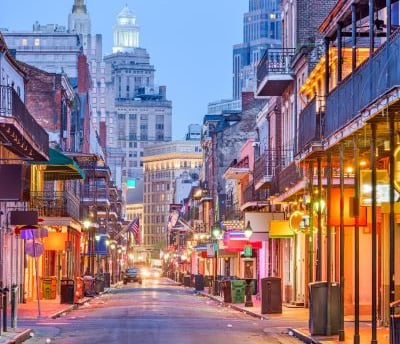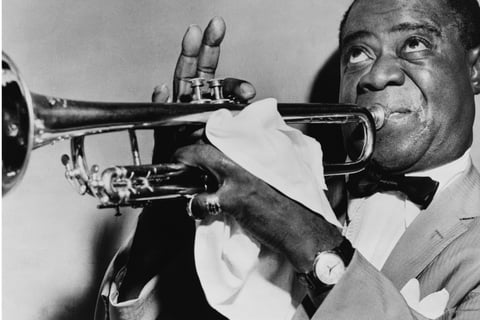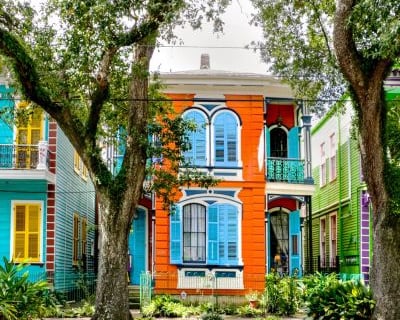Exploring New Orleans: A Guided Walking Tour Through Jazz History
Louis Armstrong, born on August 4, 1901, in New Orleans, is a towering figure in the history of jazz, renowned for his innovative approach and charismatic stage presence. Armstrong's early life was marked by hardship. Growing up in a poor neighborhood, he faced numerous challenges, but these experiences shaped him into a resilient artist. His passion for music blossomed when he received a cornet as a young boy, which would prove pivotal in his development as a musician.
UNITED STATESLOUISIANAMUSIC
12/16/20246 min read
DISCLOSURE:
There may be affiliate links on this post. If you buy something using these links i may receive a small commission at zero cost to you.
The Heartbeat of Jazz: Congo Square
Congo Square holds a pivotal role in the cultural and musical landscape of New Orleans, serving as a cornerstone for the evolution of jazz. Established in the 18th century, this historic site was a designated gathering place for enslaved individuals and free people of color. Within the vibrant heart of Congo Square, the interplay of various musical traditions began to flourish, ultimately leading to the creation of jazz as we know it today.
The importance of Congo Square transcends mere nostalgia; it is a testimony to resilience and creativity. Every Sunday, the square came alive with drum circles, dancing, and communal gatherings that fostered a sense of identity among African descendants. These performances were not just entertainment; they embodied a rich confluence of African rhythms, European melodies, and Caribbean influences, which became fundamental to jazz music. The pulse of the people resonated through the beats played here, illustrating a narrative of cultural endurance against the backdrop of oppression.
Over the years, Congo Square has witnessed significant transformations, yet its essence as a cultural epicenter remains. In the early 20th century, as jazz emerged as a distinctly American art form, the influence of these early gatherings became increasingly apparent. Musicians like Louis Armstrong and Jelly Roll Morton would later draw from the vibrant traditions that thrived in Congo Square, embodying the spirit of innovation that characterizes jazz. Today, patrons and musicians alike continue to converge at this iconic location, celebrating its rich history while enriching the ongoing narrative of jazz.
The echoes of Congo Square remain a reminder of the power of community and creativity, standing as a beacon of the rich tapestry of history from which jazz evolved. This historic landmark not only serves as a geographical point of interest but as a profound symbol of cultural significance that defined a genre and continues to inspire generations of musicians and lovers of music.
Uncovering the Legacy of Louis Armstrong
Louis Armstrong, born on August 4, 1901, in New Orleans, is a towering figure in the history of jazz, renowned for his innovative approach and charismatic stage presence. Armstrong's early life was marked by hardship. Growing up in a poor neighborhood, he faced numerous challenges, but these experiences shaped him into a resilient artist. His passion for music blossomed when he received a cornet as a young boy, which would prove pivotal in his development as a musician.
Armstrong's career took flight during the early 1920s when he moved to Chicago to join King Oliver's Creole Jazz Band. It was there that his unique style began to surface, characterized by improvisation and a distinct trumpeting technique. This new sound, imbued with his personal flair, captivated audiences and helped define the jazz genre. Armstrong's recordings from this period, including "West End Blues" and "Potato Head Blues," showcase his incredible skill and creativity. These tracks remain influential, serving as benchmarks for aspiring musicians.
Throughout his career, Louis Armstrong transcended the limitations of jazz, becoming a global ambassador for the genre. His voice, often described as rich and gravelly, complemented his instrumental prowess, allowing him to reach diverse audiences. His performances in venues ranging from small clubs to grand stages introduced jazz to millions, solidifying its status as a music genre worthy of respect and admiration. Armstrong's ability to infuse emotion into his music created a connection with listeners, making his concerts unforgettable experiences.
As a central figure in the New Orleans jazz renaissance, Armstrong's legacy continues to influence artists across various genres. His contributions laid the groundwork for future jazz musicians and contributed to the evolution of American music. A pilgrimage through New Orleans would be incomplete without acknowledging the profound impacts of Louis Armstrong, whose life story is inseparably linked to the vibrant sounds of the city.
Journey Through the Vieux Carré: The French Quarter Experience
The Vieux Carré, commonly known as the French Quarter, is a vibrant neighborhood that pulsates with the rich history and cultural heritage of New Orleans. Founded in 1718, it is one of the oldest districts in the city, renowned for its picturesque streets, wrought-iron balconies, and lively atmosphere. Walking through the French Quarter, one cannot help but be enchanted by the blend of architectural styles, from Spanish courtyards to French colonial buildings. Each structure shares stories of the generations that have called this area home, making it an essential stop for anyone interested in understanding the essence of New Orleans.
As you meander through its bustling streets, hints of jazz music can be heard emanating from various venues, telling the story of the genre's evolution. The French Quarter has played a pivotal role in nurturing countless jazz talents, serving as the birthplace of iconic musicians such as Louis Armstrong and Jelly Roll Morton. Notable jazz clubs like the famous Preservation Hall have become iconic in their own right, hosting nightly performances that illustrate the transformative power of jazz. These establishments not only highlight the music but also serve as cultural touchstones that draw locals and visitors alike to experience the genre's authentic roots.
The significance of the French Quarter in the history of jazz cannot be overstated. The district's unique atmosphere and open embrace of artistic expression have allowed diverse musical styles to flourish, ultimately shaping the sound of jazz we know today. As you explore the captivating streets filled with art, food, and music, you will find that the French Quarter encapsulates the very heart of New Orleans' musical identity. It is a journey through time, music, and culture, revealing how the past continues to influence the present in this extraordinary city.
Live Jazz: An Authentic Experience with Local Musicians
New Orleans is synonymous with jazz, and experiencing live performances in this vibrant city is a unique opportunity to connect with the art form. The culmination of a guided walking tour through the streets steeped in jazz history leads participants to the heart of the live music scene, where top local musicians continue to keep the spirit of jazz alive. The ambiance in legendary jazz clubs—filled with the sounds of upbeat melodies and soulful rhythms—offers an immersive experience that transports listeners back to the origins of this captivating genre.
Local talent plays a pivotal role in preserving the rich traditions of jazz while simultaneously infusing their own contemporary styles. Musicians often share personal stories and insights into their experiences, creating a bond between the artist and the audience. As attendees enjoy the spontaneous and electric energy of live performances, they witness firsthand how these artists embody the legacy of legends such as Louis Armstrong and Jelly Roll Morton, while also innovating beyond the boundaries of traditional jazz.
In intimate venues, participants can savor the atmosphere that defines New Orleans' vibrant culture. Each performance is an opportunity to embrace the improvisational nature of jazz, where every note comes alive through the musicians’ creativity. This unique setting allows audiences to appreciate not only the technical skill of these artists but also their dedication to preserving and evolving the genre. The interactions and shared experiences foster an appreciation for the various influences that shape modern jazz in New Orleans, making it a rich tapestry of sound.
Finally, when attendees leave these jazz clubs, they carry with them not just memories of the music but a deeper understanding of how local musicians contribute to a thriving art scene. By attending these performances, visitors to the city become part of a living history, participating in a vibrant tradition that continues to resonate through generations.
Summary:
Discover the origins of jazz and explore New Orleans' vibrant contemporary jazz scene
Experience the charm of the French Quarter, Louis Armstrong Park, and iconic Bourbon Street
Relax with a drink in hand as you enjoy live music at an authentic jazz club
Gain exclusive insights into the culture and behind-the-scenes workings of live music venues
Take part in a carbon-neutral tour, hosted by an eco-certified tour operator
Availability: all seasons. Check availability here!
Includes:
Guided walking tour
Expert guide
Live music experience
Choice of an alcoholic or non-alcoholic drink








